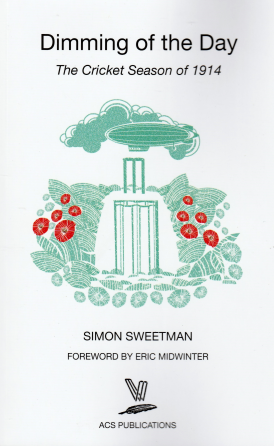Dimming of the Day
Martin Chandler |Published: 2015
Pages: 122
Author: Sweetman, Simon
Publisher: ACS
Rating: 3.5 stars

It is testament to the appeal of cricket history that the centenary of the Great War has produced so many books. This is the fifth we have reviewed so far, and there are certainly others. I am no expert on the bibliography of other sports, but have seen only the occasional book inspired by the conflict – such is the appeal of the literature of our great game.
A surprising feature of the books is that all have managed to offer something slightly different, from the encylopaedic masterpiece of Wisden on the Great War, to the rather more parochial For Kent and Country. Less ambitious but no less enjoyable are a couple of booklets based on Gloucestershire and Hampshire cricketers. Nigel McCrery’s Final Wicket I have yet to read, but even the flawed Final Over makes a contribution. First to the market was Brian Halford’s compelling biography of Percy Jeeves, The Real Jeeves.
So what does Dimming of the Day add to this rich harvest? It is of course a cricket book, and dwells at some length on the English cricket season of 1914, but that is only part of its purpose. A collaboration by a number of authors the book’s primary aim is to put the summer in context. In doing so the so-called Golden Age, which supposedly ended with the gathering of the clouds of war is, to an extent, de-romanticised. Beyond that the reader is reminded that as the 1914 cricket season opened, British society had a number of concerns that were rather more pressing than what seemed, at first, to be a rather distant prospect of the political difficulties in the Balkans escalating into a worldwide conflict.
This was a time of considerable poverty in the UK for many, with just a small middle class and a tiny upper class. But increasing industrialisation meant the working man was making a contribution to the creation of wealth for which he thought he was being ill-rewarded. The Labour movement was growing and the Liberal Government was having serious problems. The overwhelmingly Conservative and unelected House of Lords was threatening to use its powers to stop legislation and prevent the elected House of Commons from running the country in accordance with its mandate. Eventually in 1911 the Lords’ ability to do this had been severely restricted by the Parliament Act 1911, a constitutional change of a magnitude that is often, but shouldn’t be, under-estimated.
Elsewhere the second decade of the twentieth century saw the ‘suffragist’ or, as the popular press dubbed it, ‘suffragette’ movement increasing its support, influence and the extent of the disruption its members set out to cause. More dangerously to life and limb there were serious problems in Ireland where the Government had to deal with demands for independence from the majority, and at the same time an equally passionate desire to maintain the Union from a sizeable minority.
The way the book is presented is straightforward. There is an excellent introduction to set the scene followed by a series of disconnected paragraphs taking the reader chronologically through the late spring, summer and early autumn of 1914. Many of the paragraphs tell the story of the cricket season, but the labour movement, the suffragettes and the Irish get their fair share of attention as, with increasingly frequency, does the deteriorating situation in Europe. Once war is declared the emphasis changes, both in relation to what was happening on the cricket field and on the continent.
The various contributions to the book were edited by Roger Moulton, whose idea the concept was. The content of the finished product is fascinating, but the only images are five small portraits of some of the leading players of 1914 and 18 team photographs, but then the ACS standard format is limiting. I don’t feel able to give Dimming of the Day more than 3.5 stars, but in the hands of a larger publisher, and more importantly with a bigger budget, there is not a shadow of doubt in my mind that this concept would have made a wonderful coffee table book. Moulton certainly deserves 5 stars for the idea and the way the project was co-ordinated.






Leave a comment